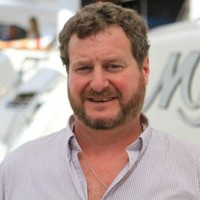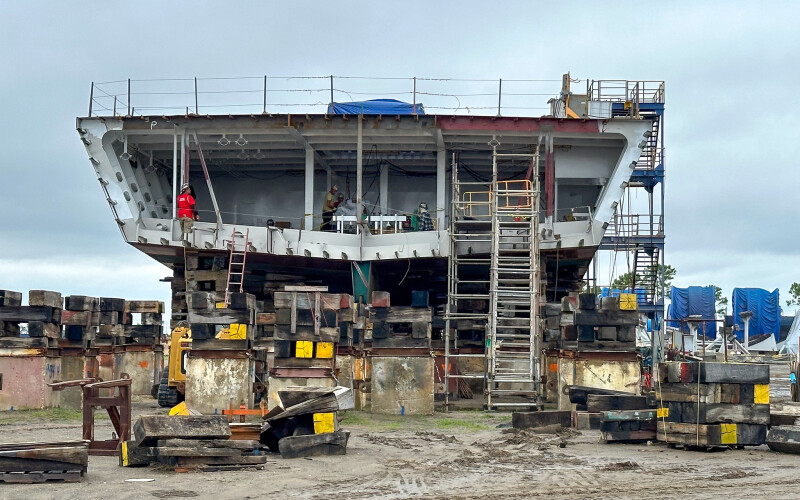Over the last year, a lot has happened in the ferry/passenger vessel sector. A substantial push toward alternative propulsion has begun, with multiple conversions and repowers underway.
Conversions to hybrid-electric, construction of new greener ferries, and infrastructure projects associated with electrification to support recharging of vessels are modernizing ferry operations.
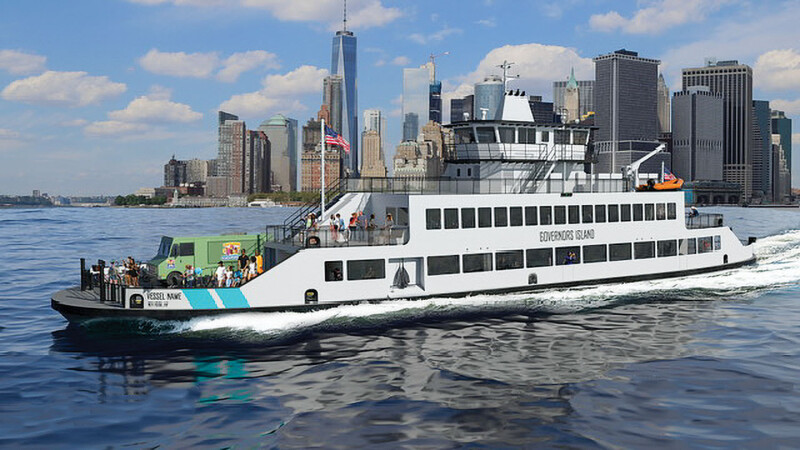
CONRAD SHIPYARD
New York City is set to introduce its first hybrid-electric ferry with the planned launch of the new Governors Island ferry in the summer of 2024. The innovative vessel, designed by Elliott Bay Design Group (EBDG), will boast a 1,200-passenger capacity, plus vehicles, and represents a significant step toward reducing emissions in New York Harbor. The ferry’s hybrid propulsion system offers the flexibility to operate on either zero-emission, battery-only power or a battery-assisted hybrid with diesel backup. The ferry is being built by Conrad Shipyard LLC based in Morgan City, La., and will replace the 67-year-old, 1,000-hp diesel-electric Lt. Samuel S. Coursen, which was commissioned by the Army in 1956.
“Since Governors Island is accessible only by ferry, we are proud that the Trust for Governors Island has selected us to play such a vital role in its growth and progress,” Conrad Shipyard CEO Johnny Conrad said earlier this year. “This ferry will be the first-ever hybrid vehicle and passenger ferry in New York Harbor.”
Conrad is getting ready to build four cutting-edge cargo and passenger ferries for the Puerto Rico Maritime Transit Authority (PRMTA). The new ferries, capable of carrying 300 passengers and 300 short tons of cargo, will connect Ceiba with Vieques and Culebra in Puerto Rico. The new passenger vessels should significantly improve regional connectivity for residents. The first ferry will be delivered in late 2024 and will immediately join the two previous ferries that Conrad built for PRMTA.
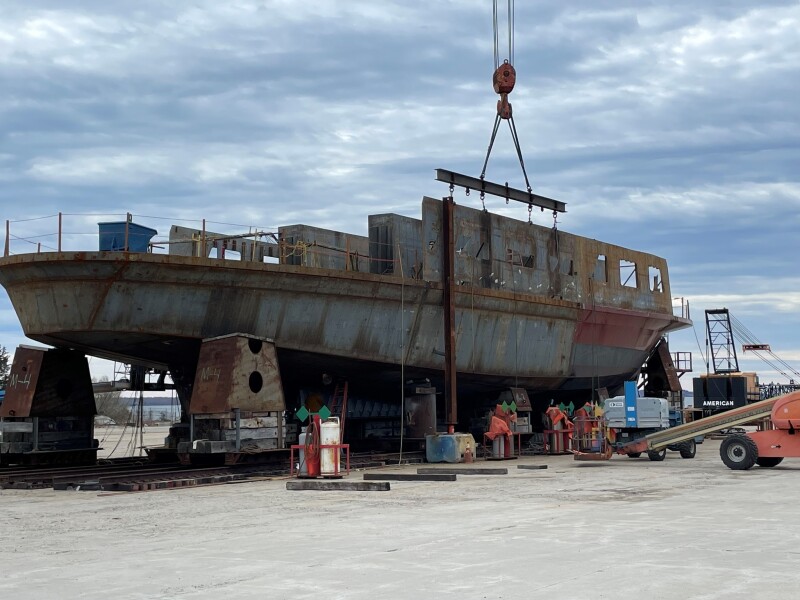
HYBRID FERRY
Pictured above is the "Capt. Almer Dinsmore," under construction at Senesco Marine in North Kingston, RI. This vessel is a Gilbert Associates passenger vehicle ferry design that has been created for the Maine DOT. The Dinsmore is a BAE hybrid propelled sister vessel to the "Captain Richard Spear,” which was built in 2021. When complete, the vessel will be the first hybrid electric-powered passenger vehicle ferry to enter service in the state of Maine.
Elsewhere in Maine, Casco Bay Island Transit District (CBITD), Portland, Maine, is upgrading its fleet starting with a new cutting-edge $25 million double-ended hybrid-electric ferry. The 164' passenger-vehicle ferry designed by EBDG is also under construction at Senesco Marine and includes substantial advancements in ferry technology and construction. It will replace the aging diesel-powered Machigonne II, a 36-year-old vessel that services Peaks Island in Casco Bay. CBITD estimates an annual reduction of 800 tons of carbon dioxide emissions with the hybrid-electric propulsion system. The vessel’s versatility is another key feature. It can operate using a diesel-electric system, a fully battery-powered system with zero emissions, or a combination of both, providing the flexibility to adapt to various operational needs.
Hank Berg, CBITD’s general manager, told a crowd at a Propeller Club meeting in June that CBITD supports a proposal from Maine’s Public Utility Commission to implement reduced rates for electric vehicles. The difference in cost would be drastic.
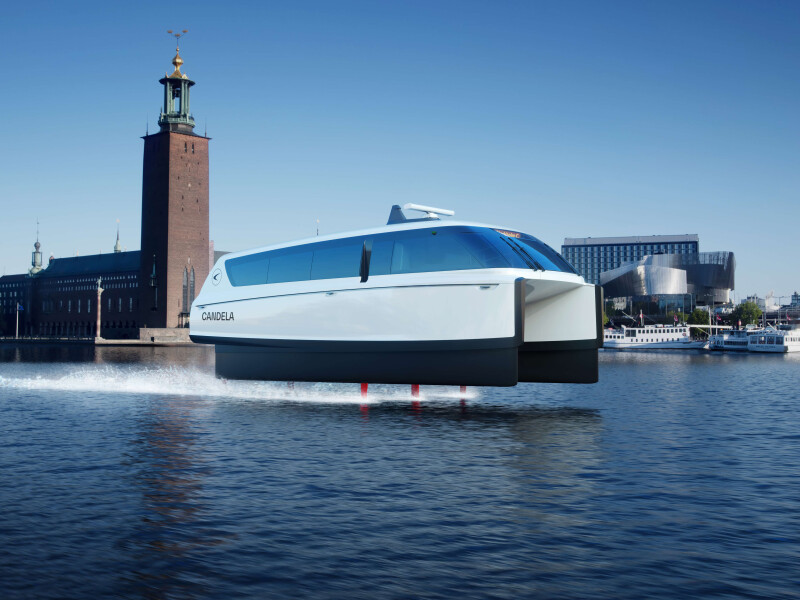
ELECTRIC HYDROFOIL
Candela Marine Tech, Stockholm, Sweden, has unveiled its P-12 Shuttle ferry design for local public transportation. The P-12 Shuttle is a 100% carbon-fiber, 39'×14.7' electric catamaran passenger ferry featuring a hydrofoil system for enhanced speed and efficiency. The hydrofoil design lifts the hull entirely out of the water, allowing the P-12 to achieve speeds of up to 30 knots while drastically reducing energy consumption. It is powered by two Candela C-POD 50-kW electric pod drives with counter-rotating propellers mounted on the aft hydrofoils. The P-12 boasts a range of 60 nautical miles per charge and can cruise at 27 knots.
A nearly silent electric motor, along with a state-of-the-art stabilization system that automatically adjusts the hydrofoil’s position up to 100 times per second based on sensor data ensures a stable, quiet ride that improves passenger comfort and reduces seasickness.
Candela has established an office in California and aims to deploy the P-12 Shuttle in various locations where fast, efficient ferry service is required, including the Sausalito to San Francisco route.
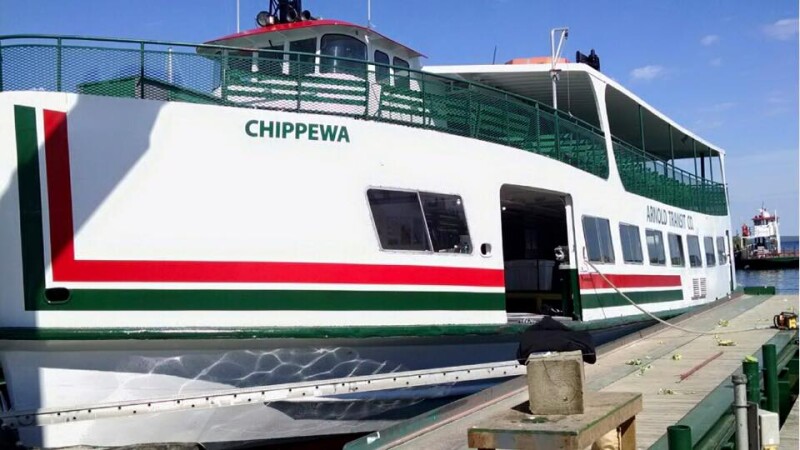
FERRY CONVERSION
The Mackinac Island Ferry Co. is receiving a $3.06 million grant from the Michigan Department of Environment, Great Lakes, and Energy’s Fuel Transformation Program to convert the 84' ferry Chippewa to electric power. The project will replace the ferry’s 1988 diesel engines with new electric propulsion motors, resulting in a significant reduction in greenhouse gas emissions. After the conversion and concurrent vessel redesign, the Chippewa, built in 1962, is expected to accommodate 250-300 passengers. The power conversion will eliminate 14,152 metric tons of carbon dioxide and 887 metric tons of nitrogen oxides over the Chippewa’s lifespan. Additionally, 1.5 MW of shore power infrastructure will be installed at the Mackinaw City ferry dock, along with electrification infrastructure upgrades at the Mackinac Island and St. Ignace ports. The conversion serves as a pilot project for electrifying 28 more Mackinac Island ferries, aligning with Michigan’s commitment to clean energy and carbon neutrality by 2050.
“Converting a ferry in the Mackinac fleet to electric will build on our clean-energy leadership and help us achieve the goals of the MI Healthy Climate Plan to make our state carbon-neutral by 2050,” Gov. Gretchen Whitmer said in a statement announcing the Chippewa conversion.
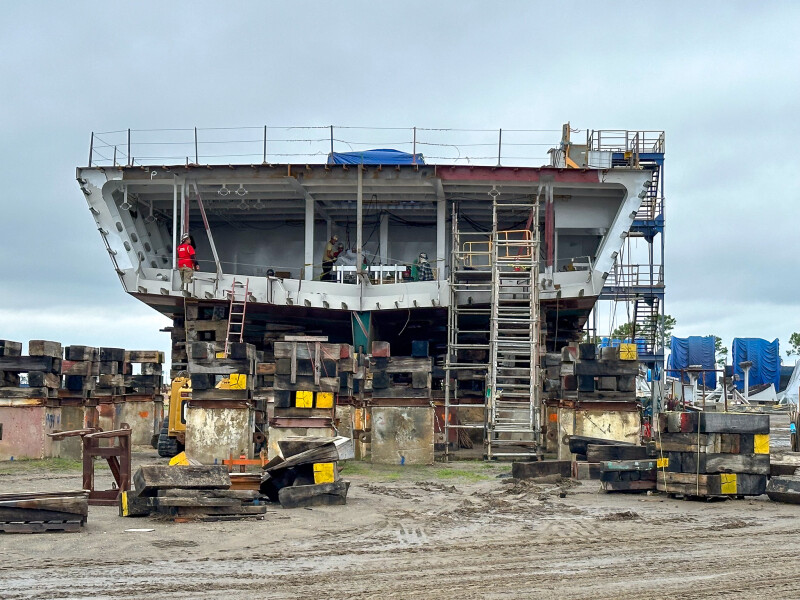
LONG ISLAND SOUND
Eastern Shipbuilding Group Inc. (ESG) is building a new 302' passenger/vehicle ferry “long Island” for the Bridgeport & Port Jefferson Steamboat Co. (B&PJF) at its Allanton Shipyard in Panama City, Fla. The new ferry, scheduled for delivery in 2024, will serve the route between Bridgeport, Conn., and Port Jefferson on New York’s Long Island. This new vehicle/passenger ferry will join the existing fleet and provide service across Long Island Sound.
The vessel is a Gilbert Associates design and will be the third sister to the P.T. Barnum built by ESG in 1999 and Grand Republic built in 2003 for McAllister. Emission reduction will be significant given that propulsion power will be provided by two, Twelve-Cylinder Tier 4 emissions-certified, EMD 12 ME 23C marine turbocharged diesel engines. The exhaust will be scrubbed through the onboard EMD Selective Catalytic Reduction system. Heating for passenger accommodations and the large crew quarter accommodations block is provided by a LEED compliant boiler and hot water circulation system. Additionally, the vessel will feature the latest technology in navigation electronics, passenger audio/visual information systems, security monitoring systems, LED lighting, and galley/food service equipment.
“We have a lot of repeat customers,” said Joey D’Isernia, Eastern’s CEO and chairman. “We’ve been doing business with McAllister for more than 30 years. When you do the right things, customers want to come back.”
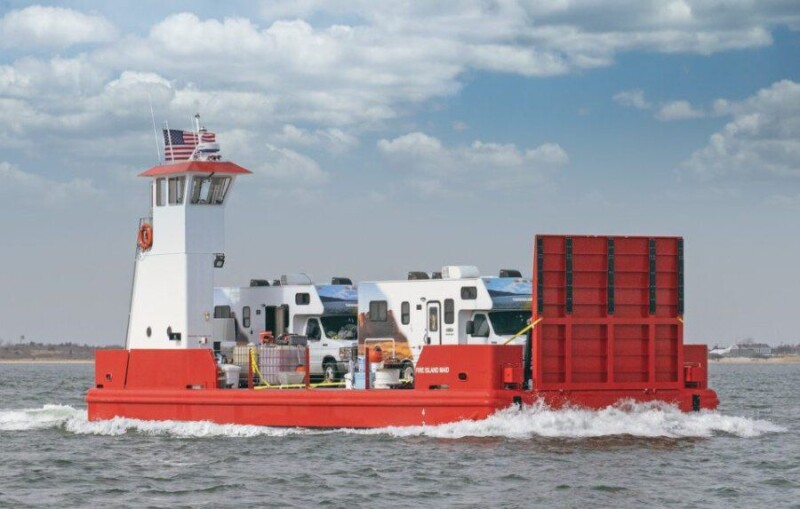
NEW FIRE ISLAND FERRY
Metal Shark delivered the Fire Island Maid, a passenger 70'x23' vehicle ferry, to Fire Island Ferries recently. The ferry was designed by EBDG and built at Metal Shark’s Bayou La Batre, Ala., shipyard.
Featuring a steel hull and aluminum superstructure, the ferry is equipped with a hydraulic ramp designed for efficiently loading and unloading cars and heavy equipment. Its reinforced deck can accommodate fully loaded concrete trucks and general cargo weighing up to 100,000 lbs. The aft pilothouse accommodates two crew members.
“We are excited to add Fire Island Maid to our fleet of vessels,” Dave Anderson, general manager of Fire Island Ferries, said when the new ferry was delivered this spring. “EBDG listened and provided a more efficient structure and arrangement. I know this new ferry will make a difference for our passengers and shipping customers.”
Powering the ferry are twin Cummins QSL9 Tier 3 marine engines with a ZF Marine CruiseCommand control system and Twin Disc transmissions. A Cummins Onan MDK generator provides ship’s service power. For ease of service, the lightship weight of 160,000 lbs. allows the ferry to be lifted with the client’s existing lift.
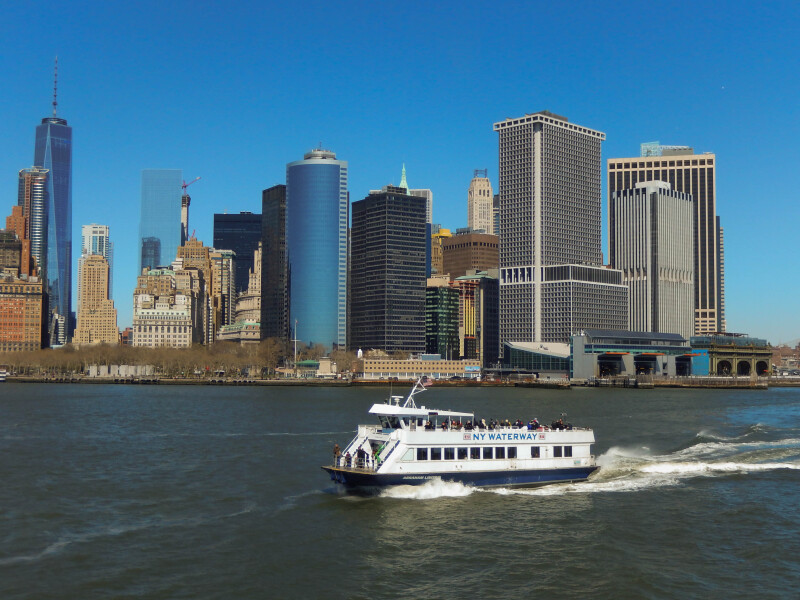
NY WATERWAY FERRY CONVERSIONS
NY Waterway, which operates ferries on the Hudson River, is set to undergo a significant transformation in its fleet thanks to a $7.3 million federal transportation grant. The money will enable NY Waterway to install hybrid engines in up to four of its ferries. The ferry upgrades involve replacing existing main engines and generators with two electric-driven propulsion motors, a battery bank, and two smaller emergency generators for redundancy.
The transition to hybrid technology is expected to result in substantial reductions in fuel consumption, emissions, and engine noise while also enhancing air quality around ferry terminals. The upgrades lay the foundation for future conversion to all-electric propulsion, aligning with NY Waterway’s commitment to greener, more efficient operations.
Editor's Note 12/22: A previous version of this article misidentified the vessel in the Senesco Marine photo and the source of some of the vessel designs. The article has been updated accordingly.



